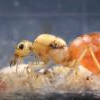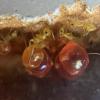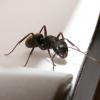- Formiculture.com
- Forums
- Gallery
- Members
- Member Map
- Chat

Avoid Acrylic Nests
Started By
nurbs
, Sep 20 2018 10:06 PM
31 replies to this topic
#21
 Offline
-
Posted September 22 2018 - 1:11 PM
Offline
-
Posted September 22 2018 - 1:11 PM
I've always loved the look of acrylic nests, but from the beginning I've heard various reasons not to use them. I also don't like the way garbage is very noticeable, sort of lowering the "grandness" of the ants.
"Bow Legged." Basically ants that do not perform well with slippery surfaces have their second pair of legs star spreading a little too far. I have experienced this with Camponotus Pennsylvanicus. My homemade remedy to this is either sand, or grout. Formic Acid. Many formic acid spraying species don't do well in these formicariums. Their acid does not get absorbed, and builds up to lethal amounts. But another simple fix; grout or sand. I only own 2 acrylic formicariums myself. The first was a stupid purchase of an Omni Nest. AC products in general aren't very great for their purpose. Now, I do have a 50+ worker colony of C. Pennsylvanicus thriving in there. I also used sand to help them better grip the flooring of the nest and to absorb any formic acid sprayed. The other nest was an Ants Australia Size 1 Founding Formicarium. I bought it mainly because of the way it looked. I've had multiple queens/ small colonys live in it, and all but one have passed away. The one left was later moved to a test tube, due to my past experience. And now seeing that others have had prior experience, I'm starting to become uneasy about acrylic nests.
Here is a YouTube video of a MASSIVE Argentine Ant colony living in an acrylic nest over a meter large. They are invasive and easily adapt, so this probably isn't the best example.
If I was to choose one Formicarium, suited for almost any ants needs, I would choose Drew's starter Formicarium in a heartbeat. All in one Formicarium and outworld, easy to access drinking source, very well priced, 1 month water reservoir, appealing to the eye, and great for photography. I recommend to all.
"Bow Legged." Basically ants that do not perform well with slippery surfaces have their second pair of legs star spreading a little too far. I have experienced this with Camponotus Pennsylvanicus. My homemade remedy to this is either sand, or grout. Formic Acid. Many formic acid spraying species don't do well in these formicariums. Their acid does not get absorbed, and builds up to lethal amounts. But another simple fix; grout or sand. I only own 2 acrylic formicariums myself. The first was a stupid purchase of an Omni Nest. AC products in general aren't very great for their purpose. Now, I do have a 50+ worker colony of C. Pennsylvanicus thriving in there. I also used sand to help them better grip the flooring of the nest and to absorb any formic acid sprayed. The other nest was an Ants Australia Size 1 Founding Formicarium. I bought it mainly because of the way it looked. I've had multiple queens/ small colonys live in it, and all but one have passed away. The one left was later moved to a test tube, due to my past experience. And now seeing that others have had prior experience, I'm starting to become uneasy about acrylic nests.
Here is a YouTube video of a MASSIVE Argentine Ant colony living in an acrylic nest over a meter large. They are invasive and easily adapt, so this probably isn't the best example.
If I was to choose one Formicarium, suited for almost any ants needs, I would choose Drew's starter Formicarium in a heartbeat. All in one Formicarium and outworld, easy to access drinking source, very well priced, 1 month water reservoir, appealing to the eye, and great for photography. I recommend to all.
- CamponotusLover likes this
#22
 Offline
-
Posted September 22 2018 - 10:00 PM
Offline
-
Posted September 22 2018 - 10:00 PM
My personal opinion is that given regular care, acrylic nests can work for quite a lot of species. However there are many issues that are more likely to arise from acrylic over any of the other more popular natural or semi-natural nests. I do not believe that acrylic itself kills ants. Instead I believe that the intensive planning for upkeep, designing of the structure itself, and care over time required to make them work is not averagely displayed except in cases where there is a determined and quite knowledgeable individual involved. I prefer natural btw, but I don’t agree with the entire condemnation of the material itself. I have used it in quite a few application for varying California species with success as long as I kept a more vigorous maintenance routine. So I must say that the problem with acrylic is most definitely not the material, but the lack of absolutely perfect design that is more required in a setup where the ants do not have the ability to contribute to their nesting environment.
- TheRealAntMan likes this
A question that sometimes drives me hazy: am I or are the others crazy?
#23
 Offline
-
Posted September 22 2018 - 11:11 PM
Offline
-
Posted September 22 2018 - 11:11 PM
If I was to choose one Formicarium, suited for almost any ants needs, I would choose Drew's starter Formicarium in a heartbeat. All in one Formicarium and outworld, easy to access drinking source, very well priced, 1 month water reservoir, appealing to the eye, and great for photography. I recommend to all.
Not to disparage Drew, and I respect everything he does, but I'm not sold on epoxy based nests. Most of his Camponotus don't do well in his starter formicariums which I believe have an epoxy floor with sand. In fact, he came by the other week just to pickup my season 2018 C. sansabeanus and C. laevigatus because he didn't have any strong healthy colonies. Mine are in test tube setups in pencil case formicariums with a hydrostone base, many up to 20+ workers now. Drew told me he dumped them out and put them into his formicariums. We discuss daily on how are colonies are doing, so I'm curious how well they do.
Not that I'm saying none of my own colonies die. I find dead mexicanus queens every week.
My personal opinion is that given regular care, acrylic nests can work for quite a lot of species. However there are many issues that are more likely to arise from acrylic over any of the other more popular natural or semi-natural nests. I do not believe that acrylic itself kills ants. Instead I believe that the intensive planning for upkeep, designing of the structure itself, and care over time required to make them work is not averagely displayed except in cases where there is a determined and quite knowledgeable individual involved. I prefer natural btw, but I don’t agree with the entire condemnation of the material itself. I have used it in quite a few application for varying California species with success as long as I kept a more vigorous maintenance routine. So I must say that the problem with acrylic is most definitely not the material, but the lack of absolutely perfect design that is more required in a setup where the ants do not have the ability to contribute to their nesting environment.
Is that your personal opinion or have you actually tried? I have put many of my personal colonies into acrylic nests and killed them with magnificence. Species such as Veromessor, Pogonomyrmex, Camponotus, and Myrmecocystus. It's all a fail.
I've never care much for Solenopsis, so never dropped them in acrylic nests.
Can you expand on what you do with your "vigorous maintenance routine"? What CA species have you had success with? I'm very curious. Pictures if you have them.
Also, what does "Instead I believe that the intensive planning for upkeep, designing of the structure itself, and care over time required to make them work is not averagely displayed except in cases where there is a determined and quite knowledgeable individual involved" mean?
Instagram:
nurbsants
YouTube
California Ants for Sale
Unidentified Myrmecocystus
https://www.formicul...ls-near-desert/
Undescribed "Modoc"
https://www.formicul...mp-ca-5-4-2017/
Camponotus or Colobopsis yogi:
https://www.formicul...a-ca-1-28-2018/
Camponotus us-ca02
https://www.formicul...onotus-us-ca02/
Unidentified Formica
https://www.formicul...l-ca-6-27-2020/
Pencil Case and Test Tube Formicariums
https://www.formicul...m-and-outworld/
Bloodworm Soup
https://www.formicul...bloodworm-soup/
#24
 Offline
-
Posted September 23 2018 - 12:40 AM
Offline
-
Posted September 23 2018 - 12:40 AM
So did you purposefully skip over the part where I stated that I only do not condemn the material? Did you perhaps misinterpret that as me stating that current modern acrylic setups are more than adequate? I’ve raised a Pogonomyrmex Calalifornicus colony in an antscanada omninest vertical for close to two years before moving them to a natural setup and giving them away (and to explain as to how much time and care I had put into attempting to make this setup work, I gave them a controlled amount of gelatinized, sterilized, and then hard dried food only in an amount enough for them to survive as to prevent any buildup since natural decomposition would not apply as well, reintroduced springtails into their chambers periodically as the populations kept dying and/or disappearing, and sterilized the hydrating sponges every 2-3days while making sure that the ‘capillary-like’ functions were unobstructed) I in no way stated above in my previous post that they are ideal, so what was your issue? To say that the physical property of acrylic has mysteriously killed you’re colonies in the past is insane. You have provided no evidence of this being true, rather only that those specific nests (most likely with inadequate designs to suite the needs of ants if they are to survive the disadvantages of acrylic materials) have killed your colonies in the past. Acrylic has unnatural disadvantages, and therefore must be complimented with unnatural advantages in order to succeed. I never stated they were my choice of formicaria or that I even would consider them beneficial in any way that a natural setup could not be. Only that it is not impossible to do, though it is impractical in most cases.
Edited by Shaye, September 23 2018 - 12:44 AM.
- TheRealAntMan likes this
A question that sometimes drives me hazy: am I or are the others crazy?
#25
 Offline
-
Posted September 23 2018 - 11:15 AM
Offline
-
Posted September 23 2018 - 11:15 AM
Pogonomyrmex californicus in a vertical acrylic nest? Are you sure?! They can't climb ![]()
So did you purposefully skip over the part where I stated that I only do not condemn the material? Did you perhaps misinterpret that as me stating that current modern acrylic setups are more than adequate? I’ve raised a Pogonomyrmex Calalifornicus colony in an antscanada omninest vertical for close to two years before moving them to a natural setup and giving them away
- dermy and YsTheAnt like this
Instagram:
nurbsants
YouTube
California Ants for Sale
Unidentified Myrmecocystus
https://www.formicul...ls-near-desert/
Undescribed "Modoc"
https://www.formicul...mp-ca-5-4-2017/
Camponotus or Colobopsis yogi:
https://www.formicul...a-ca-1-28-2018/
Camponotus us-ca02
https://www.formicul...onotus-us-ca02/
Unidentified Formica
https://www.formicul...l-ca-6-27-2020/
Pencil Case and Test Tube Formicariums
https://www.formicul...m-and-outworld/
Bloodworm Soup
https://www.formicul...bloodworm-soup/
#26
 Offline
-
Posted September 23 2018 - 12:12 PM
Offline
-
Posted September 23 2018 - 12:12 PM
Pogonomyrmex californicus in a vertical acrylic nest? Are you sure?! They can't climb
So did you purposefully skip over the part where I stated that I only do not condemn the material? Did you perhaps misinterpret that as me stating that current modern acrylic setups are more than adequate? I’ve raised a Pogonomyrmex Calalifornicus colony in an antscanada omninest vertical for close to two years before moving them to a natural setup and giving them away
Yeah, I won't believe that until I see some pictures. Pogonomyrmex can't climb for the life of them.
#27
 Offline
-
Posted September 23 2018 - 12:30 PM
Offline
-
Posted September 23 2018 - 12:30 PM
I had a colony of Pogonomyrmex tenuispinus for several years, they had no trouble climbing out of their vertical glass enclosure. If they can climb glass they can certainly climb out of an acrylic nest once the inside gets a bit scratched up.
- Shaye likes this
#28
 Offline
-
Posted September 23 2018 - 2:32 PM
Offline
-
Posted September 23 2018 - 2:32 PM
Do you two have any knowledge on how the nest functions? Or did you just think “vertical? Preposterous!” I agree, they are terrible climbers, but if you knew what you were talking about in regards to how it worked you would understand how it was easily possible.Yeah, I won't believe that until I see some pictures. Pogonomyrmex can't climb for the life of them.Pogonomyrmex californicus in a vertical acrylic nest? Are you sure?! They can't climb
So did you purposefully skip over the part where I stated that I only do not condemn the material? Did you perhaps misinterpret that as me stating that current modern acrylic setups are more than adequate? I’ve raised a Pogonomyrmex Calalifornicus colony in an antscanada omninest vertical for close to two years before moving them to a natural setup and giving them away
Edited by Shaye, September 23 2018 - 2:36 PM.
A question that sometimes drives me hazy: am I or are the others crazy?
#29
 Offline
-
Posted December 10 2018 - 6:50 PM
Offline
-
Posted December 10 2018 - 6:50 PM
Awww man, what am i going to do with my AC starter pack? ![]()
#30
 Offline
-
Posted December 10 2018 - 7:11 PM
Offline
-
Posted December 10 2018 - 7:11 PM
At times I keep coming back to this thread, and still end up feeling like

- anttics likes this
#31
 Offline
-
Posted December 11 2018 - 4:16 AM
Offline
-
Posted December 11 2018 - 4:16 AM
Bought two Ants Canada Hybrid Nest 2.0 a few months ago to test out (A Camponotus and a Formica model). Not bad. Hydration can get messy if you move the nest around a lot like I do.
I used double sided stickies to adhere the glass instead of permanently gluing it on.
The Camponotus model is advertised as less humidity than the Formica model, but from my observations the Formica is way too humid.
I recommend the Camponotus model for most CA species. It also makes the best use of space IMO.
Camponotus model:
https://www.instagra.../p/Bq0dPjzFoIA/
Formica model:
https://www.instagra.../p/Bpu_Kg8FcCO/
EDIT: This nest will NOT work for Myrmecocystus or any dirt loving species. More tolerant ants such as Solenopsis, Veromessor, and Camponotus should do OK.
Edited by nurbs, December 11 2018 - 4:19 AM.
- FSTP and DaveJay like this
Instagram:
nurbsants
YouTube
California Ants for Sale
Unidentified Myrmecocystus
https://www.formicul...ls-near-desert/
Undescribed "Modoc"
https://www.formicul...mp-ca-5-4-2017/
Camponotus or Colobopsis yogi:
https://www.formicul...a-ca-1-28-2018/
Camponotus us-ca02
https://www.formicul...onotus-us-ca02/
Unidentified Formica
https://www.formicul...l-ca-6-27-2020/
Pencil Case and Test Tube Formicariums
https://www.formicul...m-and-outworld/
Bloodworm Soup
https://www.formicul...bloodworm-soup/
#32
 Offline
-
Posted December 11 2018 - 5:21 AM
Offline
-
Posted December 11 2018 - 5:21 AM
Bought two Ants Canada Hybrid Nest 2.0 a few months ago to test out (A Camponotus and a Formica model). Not bad. Hydration can get messy if you move the nest around a lot like I do.
My Simants nests are of a fairly similar design (they also have a bottom tub for hydration and if you fill that with Seramis and only water it to a point where you don't have water standing on the bottom of the tub (=only so much that the Seramis can actually absorb it) they can be transported around quite easily (obviously you want to keep them flat so the Seramis doesn't fall out through the hydration ports on the sides of the nest).
I used double sided stickies to adhere the glass instead of permanently gluing it on.
The lack of screws to hold the glass is probably the single one greatest downfall of the entire AC nest series. The Simants nests have screws that hold the glass in place, plus proper slide-in door modules that can even be replaced with a heating cable holder module and it makes everything so much easier.
The Camponotus model is advertised as less humidity than the Formica model, but from my observations the Formica is way too humid.
The size of the mesh area is pretty much insignificant for the humidity levels inside the nest, it all depends on how much water you put into the bottom tub (and how well the nest is ventilated).
I accidentally overwatered my Simants nest once (it was a version with a rather small mesh area and large chambers suited for Camponotus ants) and even after removing ALL the free water from the tub using tissue paper I still had massive condesation inside the nesting part for over 3 weeks due to all the water absorbed by the Seramis (there was no more free water slopping around at the bottom of the hydration tub).
EDIT: This nest will NOT work for Myrmecocystus or any dirt loving species. More tolerant ants such as Solenopsis, Veromessor, and Camponotus should do OK.
Flat nests basically don't work for any sort of ant that loves to cling onto the ceiling. Odontomachus also have a reputation for doing bad in test tubes, so I'd expect them to not be fond of acrylic or printed nests either.
Lasius, Formica, Camponotus, Cataglyphis, Tetramorium, Iridomyrmex, Messor (probably even Pogonomyrmex) and most of the more "typical" ants do fine in them through.
We should respect all forms of consciousness. The body is just a vessel, a mere hull.
Welcome to Lazy Tube - My Camponotus Journal
0 user(s) are reading this topic
0 members, 0 guests, 0 anonymous users



















